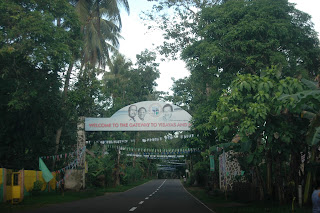Road Trip part 2
About to enter the municipality of Casiguran, Sorsogon
Established in the year 1600, Casiguran was the first missionary parish of Sorsogon. When the Spaniards first set foot in this part of Luzon in the 1570s, Casiguran was considered as their center of Kabikolan.
In 1583, the Franciscan missionaries took over the evangilization work started by the Augustinians.
The name Casiguran is believed to come from the Bicol phrase kasi gurang, meaning, mostly old, pointing to the fact that it was the first parish and therefore to be considered to be populated by senior inhabitants.
It is also believed that the town was named Casiguran because, during the Spanish times, all the young men and ladies were kept hidden and only old people can be seen in the town. The reason of the townspeople for this is that the young people are being abused by the Spaniards, thus, kept them in hiding. One day, Spaniards set foot in the soil of the town and asked for its name. The people did not understand their language. Thinking that the Spaniards were asking why there are no young people, the people answered, "kasi gurang" (because only old people live there). The Spaniards thought that "Kasi gurang" was the name of the town. They left repeating the words "kasi gurang" as not to forget them, until it came to be called as "Casiguran."
Entering the Municipality of Irosin, Sorsogon
Earlier than 1847, Irosin was a far inland valley unspoiled by human settlers and covered by vast forest expanse teeming with wild animals. Irosin was among the last places in the Philippines to be populated. Most of the natives during the early 19th century lived along the coastal areas where it was more accessible to commercial, travel and communication activities at the time. The place have been an undisturbed sanctuary for wildlife until settlers from Bulusan in search of wild quarry and rattan came. These pioneers, using the slash-and-burn method, cleared a settlement beside a river which gave birth to a clearing called Hin-ay, an Albayanon word which denotes the arrangement of the abaca yarn or tupos into a zigzagging pattern (hinan-ay) in preparation for its actual weaving. Accordingly, the hin-ay or the pattern was the image drawn to connote the waving rivers crisscrossing from the mountains down the valley. In yet another account, the word hin-ay was purported to have been derived from the term an-hay which means gradually ascending. The original settlement which is now called San Agustin is located east of the town proper at a higher elevation, thus the gradual ascent from the lower villages to the then barrio center of San Agustin.























































No comments:
Post a Comment